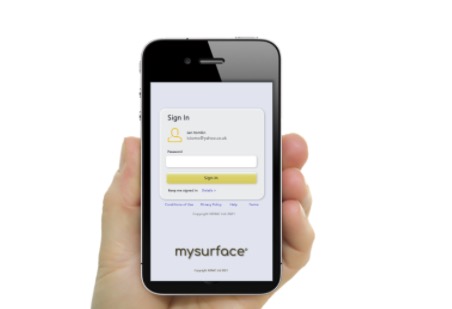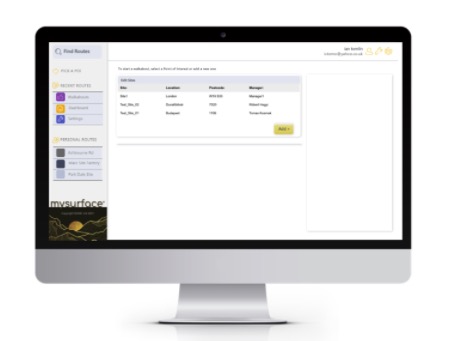EXPERIENCE ENCANVAS IN 60-MINUTES!
We're always happy to walk you through Encanvas no matter where you are in the world.

I write a fair few business books on or around the subject of enterprise IT, but rarely do I make predictions. Being English, I’m naturally cautious. But I think this year we will start to see the first shoots of a codeless enterprise software future, where robots and wizards take over from humans on the majority of enterprise software developments.
It’s strange to think how things have changed in the enterprise computing industry over time and to reflect on those moments when hype curves finally kicked-off, or disappeared without a fizz and bang, like flat party balloons. That said, I’m pretty confident about the impact of this one, and the fact it will happen very soon.
Examine past predictions and it’s apparent that humans aren’t very good at predicting the future of enterprise tech. Many of us still remember the ‘millennium bug’ panic that happened at the turn of the century with many IT pundits expecting hundreds of computers to simply stop working at the gong of Big Ben at midnight.
But the impact? It led to lots of IT leaders holding their breath when the moment came, and plenty of overtime in IT departments, nothing more.
Examples of mobile and web desktop apps designed and deployed on codeless enterprise software


Agility became the subject of my first book – Agilization – that I started writing in 2002 after a couple of years of management consulting in Europe. I was consulting for large corporations and their inflexibility in IT, methods, and organizational structures was crippling their growth. I became ever more convinced agility was something people talked about but didn’t know how to turn into a sustainable attribute of culture and behavior.
In all this, the biggest challenge they faced was the intransigence of departmental and IT leaders prepared to consider a new way of working. Back then, practically everything in the business was hard-coded.
Exec teams saw their organization chart as a true reflection of their organizational design, they were buying ERP systems that were a blueprint design that every other competitor was also adopting. The idea of agile workforces, agile IT, agile business models seemed ‘out there.’
Since the COVID-19 pandemic, we’ve seen agile organizations come to the fore and pounce on the market changes that have happened.

This decade, I predict we will finally see Codeless enterprise software take center stage in enterprise computing. It will have a more profound impact on the IT world than most commentators forecast. The IT industry has been trying to remove coding from the list of necessary skills to create apps since the millennium.
It began with Enterprise Mashups leading the charge. Gartner predicted these tools would fill the void between inflexible ERP systems and business model orchestrations, serving the long-tail of demands for apps that could be used by individuals, teams and departments to get jobs done.
Within a couple of years, Enterprise Mashups got redefined as Situational Applications solutions.
Then, the enterprise IT audience got bored. But now, pretty much the same group of entrepreneurs that started building application platforms to remove coding from application design, deployment and operations have resurfaced as application Platform as a Service (aPaaS), High Productivity applications Platform as a Service (HPaPaaS) and yes, Robotic Process Automation (RPA) brands.
I believe this decade, this time around, Codeless enterprise software platforms are going to hit their mark for three very good reasons:
1. Digital transformation pressures
Digital transformation agendas sparked by new digital technologies and the rapid pace of Business model changes is increasing demands for adaptive apps platforms that reduce the time to market, costs and risks of producing and managing apps.
2. Data security
Data security threats mean companies can no longer tolerate spreadsheet apps, self-authored apps that IT can’t govern, and the existence of shadow data means that spreadsheets are no longer a sustainable answer to citizen developer requests.
3. Tooling
With advances in AI emerging every day, the tooling for low-code and no-code development is getting seismically easier to use and with integration Platform as a Service (iPaaS) technology innovations. Technologies like Encanvas’s hyperdrive plugin permit the use of third-party DLLs, code, script, data sources, etc., there’s no limit to the type or scale of applications businesses can design for themselves.
4. COVID-19
I think COVID-19 has increased pressures on IT solutions to be more agile, and faster to develop. There is a pent-up demand now to build and adapt enterprise apps on a scale, and at a pace, that we’ve never seen before.
The notion that software development teams will sit down in scrums and start coding new apps in agile scrums seems truly outmoded by codeless. New codeless platforms offer MUCH MORE rapid development and integration (with almost no testing overhead). And, thanks to the use of robots and wizards in the software development process, it’s now possible to displace the need of human coders to write the majority of code.
COVID-19, then, might well represent the death-nail in what is now exposing itself as an ageing industry built around human coding of applications.

Ian Tomlin is a management consultant and strategist specializing in helping organizational leadership teams to grow by telling their story, designing and orchestrating their business models, and making conversation with customers and communities. He serves on the management team of Encanvas and works as a virtual CMO and board adviser for tech companies in Europe, America and Canada. He can be contacted via his LinkedIn profile or follow him on Twitter.
Now read:

What Does the Future Hold for No-Code App Development?
Written by Ian C. Tomlin | 12th January 2024
2023 saw a significant boost in the popularity of No-Code platforms, as many businesses concluded the best way to grow out of an economic downturn (resulting from the pandemic) was to innovate. Will 2024 be the year that no-code application development takes hold? If so, what innovations can enterprise buyers expect from state-of-the-art platforms like Encanvas? Read this article to find out.
Few people involved in the enterprise applications development market would be unaware of the strong bias towards manual coding. The industry has been run by people who themselves trained as coders. These individuals have invested in coding. No question, coding offers unlimited versatility while any form of abstraction layer will inevitably lead to inflexibilities. These inflexibilities come in the form of functionality shortcomings built into apps, or in the ongoing platform architecture—making it more difficult to protect data, integrate with other systems, scale apps or manage User and Group permissions.
This has led some IT leadership teams to focus their cultures and behaviors around coding. When this happens it inhibits speed-to-market and business outcomes. It is assumed, through this professional bias, that any product claiming to be able to produce enterprise apps without coding is intended for ‘citizen developers’—which these days has become industry-speak for ‘amateur.
The great thing about working with teams of awesomely clever and passionate people wanting to solve a problem, is they don’t see things like ‘bias’ as being an insurmountable obstacle; but rather just another bridge to cross.

When Encanvas deployed its first enterprise platform for a top 5 professional services company back in 2002, it proved that a no-code appdev platform could do something coder couldn’t. And, in 2003, when it produced a system to manage Advanced Roadworks Plans for a community of over a hundred organizations digging up roads across Greater London, it proved that No-Code can handle ultra-complex enterprise IT challenges better than coded solutions.
The challenge has been to convince a profession whose holy grail is the manual creation of code, that there is a better way of producing enterprise apps. Thankfully, enterprise projects to create apps have grown in volumes exponentially because of the potential of digital technologies to offer significant cost savings and customer service improvements. Speed-to-market of new applications has led to a drive for smarter ways of building apps. Every business has become an innovation factory. In 2021, more enterprise buyers than ever started to explore the possibilities of no-code.
Most No-Code solutions start their life by making it simpler to develop basic forms-based applications. Almost any enterprise app born in the early 2000s required humans to enter data into it. Understandably, the numeracy of department-level forms-based apps has created a demand for rapidly deployed, ‘designed-to-fit’ solutions. This requirement has shaped the feature sets of No-Code tools. Features to expect include:
To be awarded ‘Best No-Code Platform 2022’ solutions need to reduce or remove the amount of mundane coding tasks needed to author and deploy forms-based apps. Early solutions weren’t much different to DataEase or Microsoft Access (if you remember these popular self-authoring tools of the 1990s). Typical design elements included text, text area, numeric, date-box fields (etc.) and presentation building blocks like tables and charts.
Tools had to offer simple user journeys to intuitively guide developers through the stages of app design and deployment, including ‘one-click publishing.’ Few people are prepared to read user manuals anymore, so if Users can’t work out how to work with a tool without referring to a user manual, it won’t be popular with modern tech buyers.
A big ‘digital tech’ shot in there arm for No-Code platform vendors has been the evolution of cloud platforms like Amazon EC2 and Microsoft Azure. Large tech vendors have invested billions of dollars into their cloud infrastructures and middleware tools over the past two decades. No-Code platforms are able to harness these capabilities to make it easier to integrate, secure and scale applications; both in their audience size and number. Much of the ‘heavy lifting’ for the back-office IT tasks is ultimately being performed by the cloud infrastructure supplied by one of the top 5 cloud vendors.

The demand to speed up the time-to-value of apps has led organizations to create Development Operations (DevOps) teams. These IT teams use agile scrum development methods to fast-track app developments. While operational innovations in DevOps teams and agile have revolutionized the pace of app development, they still gravitate towards coding and coders; which means they still don’t quite remove the barriers between IT and the business. Business bosses remain hungry for FASTER, CHEAPER applications development. This leads to a move towards ‘Fusion Teams’ that fuse IT and Business People together in workshop-oriented app development teams.
According to the latest thinking by Gartner, DevOps teams are about to get displaced in the enterprise by FUSION teams. They say, “Many firms pursuing distributed delivery are transitioning to “fusion teams” to bring together IT and business employees to develop digital solutions. As fusion teams become more prevalent, enterprise architecture and technology innovation leaders must actively support these blended, multidisciplinary teams.”
Fusion teams equipped with No-Code software—such as Encanvas, Mendix, OutSystems, BettyBlocks, etc.—encourage open discussions between the people who know what an app needs to do, and the Business Analysts (not coders) responsible for authoring the app solution. This results in better-fit apps, built faster.
While Low-Code tools reduce the amount of coding that needs to be done when creating apps, No-Code solutions remove code from the screen when apps are being developed. Coding is displaced by an abstraction later of ‘LegoTM’ styled building blocks that are designed to serve the various demands expected of the design element. For example, ‘Buttons’ can perform layer-upon-layer of actions to update data, check values, automate email workflows and escalations, etc.
Of course, when you only need one person to build an app, there’s no point having a SCRUM for one. This means Agile Development methods and tools are also having to adapt to this new reality. Additionally, you can expect No-Code platforms to offer an Asset Library to manage assets and re-usable components. Tools like Jira and GitHub used by coders to manage code blocks in a traditional manual coding ecosystem are no longer needed. Instead, simpler ideation and project management tools are used to track progress of what are essentially much simpler and shorter projects, involving far fewer people.

Here are a few pointers to some of the latest innovations in enterprise No-Code platforms:
It’s no longer necessary for the people designing and deploying apps to be in the same room. The pandemic of 2020 has encouraged the evolution of remote development tooling into No-Code platforms.
Encanvas, for example, supports an encrypted Passport system for its remotes designers and architects to make access to the platform simple for users, whilst improving platform security compared to applications using two-factor authentication (which presents the risk of someone stealing a Users’s smartphone). Using Passports, designers can safely build apps online with business stakeholders on Zoom, in a Google Huddle, or on Microsoft Teams. No data gets saved to the local devices and no enterprise data connections are exposed.
We can imagine 2024 as being the year that artificial intelligence starts writing code, perhaps not as much as humans to begin with, but we can imagine it will get there! Already, Google’s Gemini is getting pretty nifty at supplying ready-to-use CSS scripts that take the load off of developers. While fully coding applications may be a while off, we can imagine systems adopting AI tools to allow users to specify their requirements in a more transferrable and adoptable form.
One of the main reasons why enterprise projects fail is the quality of data or the inability to harvest and blend data. The latest innovations in No-Code platforms go a step further with integrated No-Code tooling to mash up data from multiple sources and provide rich back-office software robots to orchestrate data uploads securely. These built-in No-Code features mean organizations no longer need to invest in third-party data integration or Extract-Transform-Load middleware.
The big new phrase in the digital transformation industry is Hyper-Automation; or the ability to apply best-fit Digital Technology solutions to process improvements without incurring high frictional costs. Enterprise No-Code platforms are now able to plug in third-party AI algorithms, Maps, DLLs, code, script, blockchain, data visualizations, social messaging tools, etc. to make it simpler for companies to embed tech innovations into business processes without having to find third-party tools.

DIGITAL DOCUMENTS REMASTERED
Micro-Portals • Forms • Reports • Training Dashboards • Charts • Maps • Tables Checklists • Onboarding • Risk Registers • Presentations • eBooks
The last decade has seen tools evolve for coders and non-coders. With the advent of Fusion Teams, No-Code platform vendors like Encanvas are now producing tooling to serve both audiences; namely, No-Code applications development tools for fusion teams underpinned by a No-Code cloud ecosystem for IT people to use so they can create data integrations, serve up an AppFabric, manage deployments, scaling, data security and User permissions.
Could this be the final step in the evolution of applications engineering; taking it from manual coding to codeless applications design and deployment? Probably not, but it will give business and IT leaders something to think about in 2024.

According to the latest thinking by Gartner, DevOps teams are about to get displaced in the enterprise by FUSION teams.
Many firms pursuing distributed delivery are using “fusion teams” to bring together IT and business employees to develop digital solutions. As fusion teams become more prevalent, enterprise architecture and technology innovation leaders must actively support these blended, multidisciplinary teams.—Gartner Enterprise Architecture Research Team, Feb 2020.
The term Development Operations (DevOps) has been on the lips of Digital Officers and CIOs for the past three years. This team of SCRUM crazy tech wizards has been charged with driving digital transformation project forward in double quick time. But, according to Gartner, that world is about to change—and 2021 is likely to be the year it happens.
Customers are ever more online, remote, discerning, and seeking personalised experiences. Moreover, they want to be in control of their purchasing experiences, call the shots, not be kept waiting, and they want answers when they seek them.
Technologies like Machine-Learning and Artificial Intelligence, sensor networks (the ‘Internet of Things’), blockchain, AI-driven conversational chatbots, virtual and hybrid reality, and 3D modelling are transforming customer value and experiences.
Every business needs to harness the potential of digital technologies to surprise and delight their customers, and stay competitive. That requires tech teams who can be the ‘tip of the spear’ and lead the charge. Someone somewhere needs to understand the hyper automation journey and what the outcome looks like from a tech-stack perspective.
The rapid pace of change in technologies and tools has left many traditional IT teams disorientated and confused about their role (i.e, ‘Do you want me to focus on upgrading our apps, displacing legacy systems and keeping the lights on or not?).
The solution for many organization has become what’s known as two-speed IT. Put another way, it’s about parachuting a new team of tech experts to create a Development Operations team that is equipped with the right skills blend and tech tools to implement agile developments. That was good 3-years ago, but today—IT’S STILL TOO SLOW.

The pace of digital evolution is now SO SWIFT that there’s not enough time to code the majority of apps anymore. A growing demand for short-cuts and code block re-use has popularized the use of Low-Code tools that make coding faster. These solutions, while useful, haven’t done anything to remove one of the fundamental challenges of application ideation: That is the barrier that exists between IT and the business when you use code and script.

At one time, any applications design and deployment technology that didn’t show the appropriate amount of love for the art of coding would be shunned by businesses as being ‘amateur stuff’ that wasn’t ‘enterprise-grade.’ Practitioners in the art of coding would argue that any tech platform not focused on the needs of the coder was deemed unable to cater for the vast array of requirements modern enterprise apps dictate. They even had a name for these enthusiastic amateurs—‘Citizen developers.’
That isn’t true anymore. In the past decade, cloud-based technologies have transformed the potential of Platform-as-a-Service ecosystems to support the design, deployment and operation of applications—all achieved without coding.
Platforms like OutSystems, Encanvas, Mendix, BettyBlocks, Outgrow, AppSheet and Bubble are able to offer enterprise-grade results. Some, offer integrated data crunching and interoperability tools together with the ability to ‘code if you want to’ or add existing DLLs, HTML, Javascript or C#.

These new tools enable Business Analysts to scope and design solutions, removing the ‘deep technical’ duties from the task of authoring an application. That means business people and tech people can build apps in real-time in workshops without having to create a SCRUM or run off into back-rooms to code.
While the technology is transformative, it’s taken some time for organizational designs and cultures to adjust to this new reality. FUSION TEAMS are the emerging solution to that challenge.
’Multidisciplinary digital business teams — or “fusion teams” — are critical to success in digital transformation. Progressive CIOs foster rather than fight the rise of the distributed digital delivery model and maximize value by focusing on the human aspects of managing digital business risk.’—Gartner CIO Research Team ‘Fusion Teams: A New Model for Digital Delivery, 2020.’

A Fusion Team is a cross-functional project team brought together around a particular app development initiative. It is generally a temporary organizational structure that ‘fuses together’ technical, commercial, change management, data security and legal considerations in the form of a transitional project team.
The purpose of a Fusion Team is to come together, implement the change, then go on to do other things. This means its not always necessary that the entire team has to be employed on full-time employment contracts, forging the possibility for Statement-of-Work styled project programs to be established whenever business needs are identified.
While project teams that use No-Code tooling to deliver app development outcomes isn’t particularly new, the fact that Gartner has ‘given this team a name’ and is now priming the enterprise IT market to consider a new way of working.
’Digital opportunities and risks are cross-cutting and fast changing, so it’s no surprise that most IT employees participate in flexible “fusion” teams that extend across IT and other parts of the business.’—Gartner CIO Research Team, Fusion Teams: Cross-Functional Collaboration for the Digital Era, June 2017.

In one of its latest papers, Gartner argues, ’The rise of fusion teams, or multidisciplinary digital business teams, requires CIOs to rethink the role of IT in supporting enterprise strategy.’ We would agree. The adoption of Fusion Teams into the enterprise biosphere is going to take a significant shift in attitudes and the final acceptance that coding is always going to be required for exceptional cases, but for the majority of applications building blocks, No-Code tools work just fine. It may take all of 2021, and a little time longer than that, for some ‘head in the sand’ CIOs to take on that little fact.

We live in a data driven business world. How do you tap into yours?
It’s thought Jeff Bezos was the first person to use the term Innovation Value Management (IVM) to describe data as a business asset based on its contributory value. If it wasn’t Jeff, then it was probably one of his team. Amazon is passionate about the value of its data. The company leadership team knows that capturing rich insights on its customers—their buying preferences and behaviors—offers an unrivalled competitive advantage.
When organizations shape their management approach to use data every day to make decisions, they are often described as operating a data driven culture. Organizations want to maximize the value of their data by using it to make business decisions. It’s never been more possible thanks to cloud computing and big data. And yet, the secret of driving business success through data often has more to do with the attitudes and skills of your people, than the technology they use.

Businesses that transition decision making to be evidence based, need curious minds to power change. Individuals at all levels of the enterprise must as the question ‘Why’ more often, and have data and analytical tooling at their disposal that equips them to rapidly find answers to those questions. In the digital age, a spreadsheet doesn’t quite cut it. You will need data harvesting and visualisation tools. More over, you will need data to be organized correctly in the first place, and probably cleansed of impurities. This is where low-code software apps come in.
Many of the new executive roles are analytics based. For example, in the office equipment industry, the transition to data-driven business has led many vendors to appoint Service Managers with an analytical background where previously, these roles were fulfilled by ‘the best field service engineers.’ Such roles today are largely about understanding patterns in data, managing people, and acting on escalations.
The latest research from Gartner suggests that, by 2023, data literacy will become an explicit and necessary driver of business value, demonstrated by its formal inclusion in over 80% of data and analytics strategies and change management programs.

Data has become the lifeblood of enterprise. Executive management teams are taking more of an active ownership role in BI initiatives than ever before. Once the bastion of large corporations—because they were the only community of business able to afford the extremely high price tag—business intelligence has become democratized over the last decade thanks to affordable ‘pay-as-you-use’ applications and cloud-based technologies that scale accessibility and affordability to dashboarding and data warehousing tools. What low-code software apps do is fulfil the ambition that many executives to further democratize business intelligence to every stakeholder in the enterprise, and potentially beyond it.
Creating a data driven ‘curious’ culture will help your business to understand customer behavior, react to market changes faster than your rivals and eliminate the unknowns. What organization would not want these abilities?

Armed with a new set of ambitions, organizations are establishing leadership roles to drive the transition of people, process, technology and data to evolve a data driven culture. The Chief Data Officer (CDO) role is growing in popularity as a standard bearer. According to the latest research from Gartner, this role is intended to:
In a digital era, businesses operate on data. Much of their opportunity is programmed into inbound marketing schemas and their operational performance depends on data analytics to execute hundreds of decisions based on fact—not gut-feel—to fine-tune internal processes and minimize sales costs. To create a data driven culture requires a culture change in many management teams that are accustomed to driving their business based on ‘hunches’ and ‘best guesses’ over what customers value and what they want. A digital economy means that enterprises no longer need to guess.
Jeff Bezos, the founder of Amazon is quoted as saying, “If you don’t understand the details of your business you are going to fail.”
The most commonly reported barriers to a data driven culture are:

The transition from analog to digital business behaviors has been swift; a matter of a few years. Many enterprises find themselves on the wrong side of this wave, operating without good customer, product, business or market insights. They find their operations somewhat sluggish compared to the ‘SaaSy’ new-kids on the block. Executives know, curious minds are needed to fast-track change at every level of the organization.
Attitudes to data vary across businesses. Leaders generally see it as crucial and an opportunity, while many departmental leaders find it a tantalizing prospect that’s probably out of reach. IT leaders, on the other hand, see data as a problem and a risk. And there will be many that see the surfacing of operational data as a risk, given that it might expose their underperformance. Bringing everyone on the same page will not be easy, but it is necessary to remain competitive in a digital economy.
Creating a data driven culture is a change project like any other. To be successful, your business needs to be armed with the same state-of-the-art methods and tools that your competitors will be using. Nothing less will do. That means harnessing robotics and artificial intelligence, analytical visualization tools, predictive modeling and automated escalation routines.
Unfortunately, when considered in isolation, none of this technology will actually help your business to harvest its opportunity and grow. Like most changes in business, it will take a blend of ‘people, process, data and technology’ to become a successful data-driven enterprise—and the need to change attitudes and behaviors will as always take center-stage.

Ian Tomlin is a management consultant and strategist specializing in helping organizational leadership teams to grow by telling their story, designing and orchestrating their business models, and making conversation with customers and communities. He serves on the management team of Encanvas and works as a virtual CMO and board adviser for tech companies in Europe, America and Canada. He can be contacted via his LinkedIn profile or follow him on Twitter.
Now read:

Without data, you’re just another person with an opinion
W. Edwards Deming, American Statistician
Data matters and it’s central to digital transformation. The problem is no matter how much companies invest in their data, and however they capture it, the quality will always be suspect. Without data, any ideas of digital transformation are likely to be a pipe dream. Low-code is transforming the ability of organizations to create custom apps to cleanse, organize and use their data.
Most companies hoard gigabytes of data on their finances, their products, their customers and markets. The difficulty is that almost no enterprise has its data organized in a structure that makes it easy to access. As soon as business leaders come up with ideas for business model re-invention, probably the next thought in the minds of DevOps leaders is ‘Where is the data coming from?’
Digital transformation projects have a habit of either generating new data (as in the case of sensor network-centric projects) or re-using old data (such as plotting assets or customers on a map and gaining value from location-centric perspectives), or a blend of the two. Re-using data found within the enterprise can be challenging because of data quality issues, the variations of data structures and field formats between applications, and issues getting data out of systems. This means DevOps teams need to have very good data management skills. Low-code platforms offer a smart new way for these teams to harness data that is close by but remains out of reach
How should DevOps teams approach their data challenges? Here are 10 ways DevOps teams are using Encanvas to breathe new life into their old data.
Old data may be held in various applications and formats. It’s not uncommon for Encanvas to gather information from spreadsheets, big back-office systems databases like SAP R3, IBM DB2, Microsoft Dynamics and SQL – all at the same time. Encanvas is a plug-and-play multi-threaded and multi-sourcing platform which means designers can create concurrent live data feeds from multiple systems or end-points at the same time. This capability is used extensively by designers when creating applications that re-use data from existing and new systems together, creating new data structures on the fly for the specific canvases they author as part of applications under development.
Your old data may require filtering to select only the records relevant to your project. A powerful feature built into Encanvas’s mashup environment is our special filter which allows designers to employ drag and drop controls to instantly create very powerful data filtering on inbound data from third party sources. Any number of filters can be applied to tables at the same time. For example, if a designer wants to only ingest data from a customer table of a specific type, and that relates to a specific region, they can create special filters for ‘types’ and ‘regions’ selecting only the records that apply to those conditions. All of this rich configuration is done without any coding and doesn’t influence the integrity of the ingested table, or the potential re-use of data in its native form by other applications (or canvases).
Old data may be held in various applications and formats. It’s not uncommon for Encanvas to gather information from spreadsheets, big back-office systems databases like SAP R3, IBM DB2, Microsoft Dynamics and SQL – all at the same time. Encanvas is a plug-and-play multi-threaded and multi-sourcing platform which means designers can create concurrent live data feeds from multiple systems or end-points at the same time. This capability is used extensively by designers when creating applications that re-use data from existing and new systems together, creating new data structures on the fly for the specific canvases they author as part of applications under development.
If your old data can benefit from being enriched by other sources of data, Encanvas’s mashup capabilities can really bring value by making the internal and external data accessible to applications designers without having to use coding or API to build new integrations.
Sometimes old data requires cleansing at the point of transfer from its original location using a machine to machine cleansing and transforming process to shed unwanted data and apply transformation rules to re-order, de-dupe and re-locate data to new data structures. Encanvas Software Robots make possible machine-to-machine integrations. They equip designers with the means to configure ETL actions and normalize data before it gets ingested into applications. Our software robots also automate the generation of notices to alert designers (and users too if necessary) that transformations have worked – or not. Transformations can be triggered by events, scheduled times, watch folder changes and a variety of other means.
A powerful (and pretty unique) feature of Encanvas lies in its ability to create quarantining protocols for old data that fails to live up to your expectations for data integrity. There are few good reasons to upload records that are unfit for purpose. If you are gathering customer records for example and would determine that records that fail to have any contact email, telephone or mobile numbers included are not suitable for use, then designers can create quarantining rules that filter this data out for special treatment. In such cases, the data remains ‘in the system’ but is no longer visible to users until it has been manually or machine cleaned.
It may be that old data is being ingested from multiple systems or end-points and you need to create a new data mart that has to prioritize the best likely source of good quality data over others. This can get really complicated because different systems may create new data at different speeds and this can create latency issues but, nevertheless, Encanvas has the codeless tooling to enable designers to author voting systems to vote on which source is most trusted. Voting systems can use algorithms to automatically test data integrity and then automatically augment the voting structure, or they can be manual, where the data owner or manager uses a sliding scale of trust levels to determine which source is proving to generate the best results (or both!).
When there are gaps in your old data, there are many ways that Encanvas can create new data as part of its application design. For example, the numeric controls of Encanvas allow designers to create formulas and calculations on data to total columns, sum value, source averages etc. that may be required for your new dashboards and reports but do not exist in the ingested data. Encanvas also has the ability to ingest SQL script and DLLs to make it easy for DevOps teams to re-use existing code blocks or create new APIs and transformations.
Another way to create new data is by using Encanvas’s mapping capabilities to apply location-data to existing addresses and locations. Encanvas has an integrated – and codeless – mapping engine (sometimes referred to as Geo-Spatial Intelligence, or ‘GIS’). It allows designers to plot and pin records on maps. The geo-data of records is added to the data-set (companies like Google and Microsoft charge lots of money to do this!).
Parachute in a high profile technology-centric team with a strong leader into an organization with an existing IT department it’s hardly surprising that you’re going to have to put out some fires and smooth over a few ruffles.
Balancing two-speed IT means having an internal IT team focused on reducing costs and improving process efficiencies through Business Transformation (BX) and a DevOps team re-inventing business models through Digital Transformation (DX) in tandem. Recognizing each team for its own skills and contributions to business outcomes and balancing praise is going to be important for a healthy culture.
We’ve saved the most dramatic way of fixing old data quality issues until last – because it’s no small project to build a new data warehouse to gather and re-organize data into new structures but sometimes it’s the most sustainable way to ensure that data integrity is preserved for the life of your application. For mission-critical processes, it’s probably the best quality outcome although the time and investment needed to create a data warehouse or enterprise data-hub are definitely ‘none trivial’. Encanvas includes all of the codeless tooling needed to fast-track the creation of new data warehouses and data marts using the data repository of your choice – whether you are moving towards a big data solution like Hadoop or are seeking a more traditional data structure like SQL or DB2.
So there you have it – ten ways Encanvas Low-Code can help you to turn old data into useful data for your next digital transformation.
To find out more about the capabilities of the Encanvas Low-Code platform, please contact our team.

Author
Francesca is an independent writer and head of communications for technology brands. Armed with a passion for writing about innovative technologies that can transform business, she serves on the management team of Encanvas and also works as a consultant and advisor to the executive teams of PrinSIX Technologies, Answer Pay and INTNT.AI, helping to rethink their marketing in order to tell their brand story. She can be reached via LinkedIn.